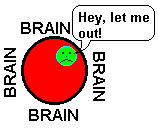Brain Damage, Therapeutics and the Blood-Brain Barrier
 Blood-Brain Barrier Less Permeable in Newborns than Adults after Acute Stroke (press release):
Blood-Brain Barrier Less Permeable in Newborns than Adults after Acute Stroke (press release):
“The blood-brain barrier is selectively permeable and blocks unwanted molecules from entering into the brain. The selectivity is achieved through fine coordination in function of many transporting systems in endothelial cells, which line the interior of blood vessels, and communication between endothelial cells and several types of cells in the brain. When blood flow in an artery to the brain is blocked by a blood clot, as occurs in arterial stroke, brain energy metabolism is compromised, and ion and other transporting systems malfunction, leading to blood-brain disruption.…The new finding suggests, the researchers said, that drugs used to treat stroke need to be tailored to the specific makeup of the neonate blood-brain barrier…“This study is a very critical step towards developing therapeutics, but these findings are a tip of the iceberg and a lot is still to be learned,” said Vexler. “We’re moving to characterize the potential for neonatal repair. Some brain damage can’t be diagnosed early, but might show up later. Now we are experimenting with postponing certain treatments or tweaking some signaling mechanisms to see if we can enhance the capacity of the immature brain to repair itself.”
To learn more:
- Good explanation, and source of pic above: The Blood Brain Barrier (Neuroscience for Kids)
- Blood–brain barrier (Wikipedia)


